
|
It brightened rapidly in outburst in mid October. Now it is bright as 8.3 mag (Apr. 11, Marek Biely). It keeps 8-9 mag until early summer. In the Northern Hemishpere, it keeps observable in the morning sky until July. In the Southern Hemisphere, it keeps observable in good condition for a long time until the comet fades out.
Date(TT) R.A. (2000) Decl. Delta r Elong. m1 Best Time(A, h)
Apr. 19 21 10.36 -7 58.8 1.814 1.769 71 8.4 5:02 (238, 48)
Apr. 26 21 23.32 -9 27.1 1.780 1.810 75 8.4 5:06 (235, 52)
|
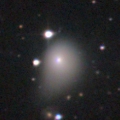
|
Now it is bright as 9.4 mag (Apr. 21, Marco Goiato). The brightening is somewhat slow, but it is expected to brighten up to 6-7 mag in 2014 autumn. It keeps observable in good condition for a long time in the Northern Hemisphere. It keeps locating low in the Southern Hemisphere.
Date(TT) R.A. (2000) Decl. Delta r Elong. m1 Best Time(A, h)
Apr. 19 14 51.88 44 33.4 1.546 2.251 122 9.4 1:07 (180, 11)
Apr. 26 14 11.60 47 37.1 1.493 2.168 119 9.2 23:50 (180, 7)
|
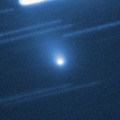
|
Now it is bright as 9.0 mag (Apr. 21, Marco Goiato). It will approach to the sun down to 0.66 a.u. in July, and it is expected to brighten up to 7 mag. Before the perihelion passage, it keeps observable until mid May in the Northern Hemisphere, or until early June in the Southern Hemisphere. After the perihelion passage, it will be observable in excellent condition after late July in the Northern Hemisphere. In the Southern Hemisphere, it keeps unobservable until early September.
Date(TT) R.A. (2000) Decl. Delta r Elong. m1 Best Time(A, h)
Apr. 19 8 13.92 -14 15.6 1.035 1.554 99 10.0 18:55 (159, 68)
Apr. 26 7 47.33 -8 21.5 1.120 1.450 85 9.9 18:48 (141, 58)
|

|
It passed only 0.4 A.U. from the earth, and 0.8 A.U. from the sun in November and December, and brightened up to 4.7 mag (Nov. 28, Juan Jose Gonzalez). Now it is 10.7 mag (Apr. 12, Chris Wyatt). It keeps observable until 2014 autumn when the comet fades out.
Date(TT) R.A. (2000) Decl. Delta r Elong. m1 Best Time(A, h)
Apr. 19 18 7.88 -11 23.6 1.474 2.117 116 10.4 4:21 (180, 66)
Apr. 26 17 56.46 -13 21.8 1.465 2.209 125 10.6 3:42 (180, 68)
|
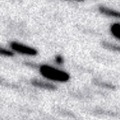
|
The condition in this apparition is bad. It locates low around the brightest days. Now it is not observable. It will appear in the morning sky at 13 mag in late July.
Date(TT) R.A. (2000) Decl. Delta r Elong. m1 Best Time(A, h)
Apr. 19 1 29.10 9 7.3 2.703 1.705 4 12.5 5:02 (268,-13)
Apr. 26 1 48.42 10 33.5 2.685 1.689 6 12.4 5:06 (265,-11)
|
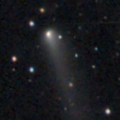
|
Now it is 12.9 mag (Mar. 28, Sandor Szabo). It will brighten up to 13 mag and to be observable in excellent condition from spring to summer.
Date(TT) R.A. (2000) Decl. Delta r Elong. m1 Best Time(A, h)
Apr. 19 14 2.21 -11 16.1 1.582 2.585 176 12.8 0:16 (180, 66)
Apr. 26 13 58.99 -10 42.3 1.575 2.580 175 12.8 23:41 (180, 66)
|
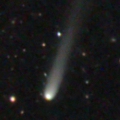
|
Now it is 14.3 mag (Mar. 30, Taras Prystavski). It is expected to brighten up to 7.5 mag and to be observable in excellent condition from summer to autumn in 2014 in the Southern Hemisphere. It keeps observable for a long time in the Southern Hemisphere, although it becomes low temporarily in May. It keeps unobservable for a while in the Northern Hemisphere. It will pass extremely close to Mars in 2014 October.
Date(TT) R.A. (2000) Decl. Delta r Elong. m1 Best Time(A, h)
Apr. 19 2 45.12 -24 42.1 3.599 2.881 38 13.1 18:55 ( 69, 14)
Apr. 26 2 47.97 -24 10.1 3.526 2.809 38 12.9 18:48 ( 68, 10)
|
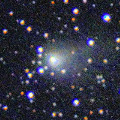
|
First return of a new periodic comet discovered in 1998. It brightened up to 10 mag at the discovery. Now it is 12.7 mag (Mar. 28, Sandor Szabo). A bit fainter than originally expected. But in the Northern Hemisphere, it keeps observable in excellent condition from autumn to spring. It locates somewhat low in the Southern Hemisphere.
Date(TT) R.A. (2000) Decl. Delta r Elong. m1 Best Time(A, h)
Apr. 19 7 27.37 16 34.3 2.079 2.185 82 13.1 18:55 (157, 35)
Apr. 26 7 39.08 15 25.7 2.163 2.197 78 13.2 18:48 (154, 36)
|
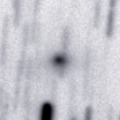
|
It brightened up to 2 mag by unusual major outburst in 2007. It is coming back now. It will be 14 mag at best by normal prediction. But actually, it is already very bright as 13.5 mag (Nov. 25, Hidetaka Sato). Now it is not observable. It will appear in the morning sky in May.
Date(TT) R.A. (2000) Decl. Delta r Elong. m1 Best Time(A, h)
Apr. 19 0 19.97 10 1.0 2.967 2.064 21 13.4 5:02 (258, 0)
Apr. 26 0 33.97 12 9.6 2.947 2.070 24 13.4 5:06 (253, 3)
|

|
It brightened up to 13.1 mag in outburst in March (Mar. 12, Chris Wyatt). Now it is faint as 16.3 mag (Apr. 20, K. Hills).
Date(TT) R.A. (2000) Decl. Delta r Elong. m1 Best Time(A, h)
Apr. 19 15 52.44 -30 59.1 5.302 6.149 144 13.5 2:06 (180, 86)
Apr. 26 15 49.64 -30 56.9 5.243 6.147 151 13.5 1:36 (180, 86)
|
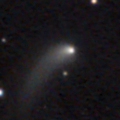
|
Now it is 14.3 mag (Mar. 30, Todd Augustyniak). It keeps 14 mag for a long time until 2014 summer. It keeps observable in good condition in the Northern Hemisphere. It keeps unobservable after this in the Southern Hemisphere.
Date(TT) R.A. (2000) Decl. Delta r Elong. m1 Best Time(A, h)
Apr. 19 3 48.77 51 10.2 2.170 1.661 47 13.9 18:55 (141,-18)
Apr. 26 4 6.32 54 3.6 2.187 1.662 46 13.9 18:48 (143,-20)
|

|
It brightened up to 11-12 mag in 2012. Now it is 13.7 mag (Mar. 28, Sandor Szabo). It will be observable in good condition at 14 mag until 2014 early summer.
Date(TT) R.A. (2000) Decl. Delta r Elong. m1 Best Time(A, h)
Apr. 19 12 20.76 -10 15.8 6.481 7.426 158 13.9 22:30 (180, 65)
Apr. 26 12 15.50 -9 44.4 6.565 7.461 151 14.0 21:58 (180, 65)
|

|
Now it is 14.0 mag (Mar. 29, Sandor Szabo). It keeps bright at 13-14 mag for a long time until 2014.
Date(TT) R.A. (2000) Decl. Delta r Elong. m1 Best Time(A, h)
Apr. 19 19 56.41 4 18.3 6.328 6.351 86 14.0 5:02 (205, 48)
Apr. 26 19 54.77 4 14.4 6.230 6.369 93 14.0 5:06 (193, 50)
|
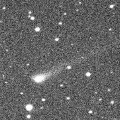
|
Now it is 14.9 mag (Mar. 5, Taras Prystavski). It keeps bright as 13-14 mag for a long time from 2013 to 2014.
Date(TT) R.A. (2000) Decl. Delta r Elong. m1 Best Time(A, h)
Apr. 19 20 36.88 -25 17.5 3.003 3.058 83 14.1 5:02 (255, 65)
Apr. 26 20 44.09 -25 14.0 2.911 3.060 88 14.1 5:06 (247, 70)
|

|
Brightened rapidly. Now it is 14.0 mag (Mar. 28, Sandor Szabo). It will brighten up to 13-14 mag and will be observable in excellent condition from spring to summer in the Southern Hemisphere. It locates somewhat low in the Northern Hemispehre.
Date(TT) R.A. (2000) Decl. Delta r Elong. m1 Best Time(A, h)
Apr. 19 8 18.23 -19 42.1 1.591 2.038 101 14.2 18:55 (158, 74)
Apr. 26 8 28.87 -18 50.3 1.606 2.010 97 14.1 18:48 (152, 72)
|

|
Now it is bright as 13.9 mag (Mar. 29, Sandor Szabo). It keeps 13-14 mag and observable in good condition in the Northern Hemisphere for a long time from 2013 to 2014. In the Southern Hemisphere, it is not observable until 2014 autumn.
Date(TT) R.A. (2000) Decl. Delta r Elong. m1 Best Time(A, h)
Apr. 19 0 54.88 52 10.7 4.279 3.603 42 14.5 5:02 (224,-28)
Apr. 26 1 0.27 51 56.0 4.317 3.622 41 14.6 5:06 (222,-24)
|

|
Big asteroid discovered in 1906. It suddenly showed the cometary activity on Dec. 11, 2010, probably due to an impact of a small object. It has already turned to be stellar.
Date(TT) R.A. (2000) Decl. Delta r Elong. m1 Best Time(A, h)
Apr. 19 2 17.04 6 49.4 4.304 3.315 8 15.0 18:55 ( 92,-10)
Apr. 26 2 25.89 7 46.2 4.319 3.321 6 14.9 18:48 ( 91,-12)
|

|
It is expected to brighten up to 13 mag and to be observable in good condition in 2015. Now it is 15.5 mag (Mar. 29, Sandor Szabo). In 2014, it will be observable at 15 mag in good condition from winter to summer.
Date(TT) R.A. (2000) Decl. Delta r Elong. m1 Best Time(A, h)
Apr. 19 13 49.70 -0 55.9 3.697 4.689 169 15.1 0:03 (180, 56)
Apr. 26 13 46.83 -0 29.8 3.668 4.649 165 15.0 23:29 (180, 56)
|
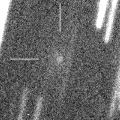
|
Now it is 17.4 mag (Apr. 13, Hidetaka Sato). It brightened up to 9 mag at the discovery in 2005. It will approach to the sun down to 0.8 a.u. on May 29. However, it will brighten up to 14 mag at best. In this apparition, it keeps observable in the morning sky all through the period. But it locates extremely low around the perihelion passage in the Northern Hemisphere.
Date(TT) R.A. (2000) Decl. Delta r Elong. m1 Best Time(A, h)
Apr. 19 21 34.90 -12 18.8 0.868 1.035 66 16.0 5:02 (249, 46)
Apr. 26 22 18.42 -9 28.8 0.863 0.977 62 15.4 5:06 (248, 42)
|

|
Now it is 16.1 mag (Apr. 15, Taras Prystavski). It will approach to the earth down to 0.06 a.u. from May to June, and it is expected to brighten up to 11 mag. In the Northern Hemisphere, it keeps observable in excellent condition until the highlight in late May while the comet will be brightening rapidly. In the Southern Hemisphere, it is not observable now. But it will be observable in mid May. Then it keeps observable in excellent condition at the highlight and after that while the comet will be fading.
Date(TT) R.A. (2000) Decl. Delta r Elong. m1 Best Time(A, h)
Apr. 19 7 36.24 71 8.7 0.371 1.000 78 15.8 18:55 (174,-17)
Apr. 26 7 59.24 69 54.1 0.316 0.981 76 15.5 18:48 (174,-15)
|

|
First return of a new periodic comet which brightened up to 13 mag in 2007. It is expected to brighten up to 13 mag again and observable in good condition from summer to autumn in 2014. But actually, it is 18.3 mag, much fainter than this ephemeris (Apr. 2, Taras Prystavski).
Date(TT) R.A. (2000) Decl. Delta r Elong. m1 Best Time(A, h)
Apr. 19 21 46.48 -9 31.0 2.759 2.473 63 15.8 5:02 (249, 42)
Apr. 26 21 57.89 -8 46.9 2.667 2.456 67 15.6 5:06 (243, 46)
|
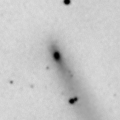
|
Now it is 15.2 mag (Mar. 30, Taras Prystavski), brighter than origianlly predicted. It will be observable at 14-16 mag for a long time from 2013 to 2014.
Date(TT) R.A. (2000) Decl. Delta r Elong. m1 Best Time(A, h)
Apr. 19 16 18.83 -25 5.8 3.276 4.108 141 15.7 2:32 (180, 80)
Apr. 26 16 16.20 -25 12.5 3.229 4.122 148 15.7 2:02 (180, 80)
|

|
It brightened up to 14.0 mag from spring to summer in 2013 (June 11, Sandor Szabo). Now it is 15.2 mag, much brighter than origianlly predicted (Mar. 28, Sandor Szabo). In the Northern Hemisphere, it will be observable at 15-16 mag in excellent condition until spring. It locates somewhat low in the Southern Hemisphere.
Date(TT) R.A. (2000) Decl. Delta r Elong. m1 Best Time(A, h)
Apr. 19 12 9.10 34 38.9 3.822 4.520 128 16.1 22:18 (180, 20)
Apr. 26 12 0.12 35 24.4 3.947 4.561 122 16.2 21:42 (180, 20)
|
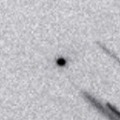
|
It approached to the earth down to 0.68 a.u. in spring, and brightened up to 15.6 mag (Mar. 29, Taras Prystavski). Now it is fading. It has already faded down to 16.8 mag (Apr. 23, E. Arce). It will be fainter than 18 mag in June.
Date(TT) R.A. (2000) Decl. Delta r Elong. m1 Best Time(A, h)
Apr. 19 10 37.01 -1 52.0 0.796 1.648 132 16.4 20:47 (180, 57)
Apr. 26 10 33.92 -5 16.2 0.851 1.653 125 16.5 20:17 (180, 61)
|
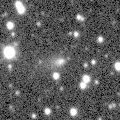
|
It brightened up to 14.7 mag in winter (Jan. 19, Taras Prystavski). Now it is fading. It has already faded down to 16.3 mag (Mar. 30, Taras Prystavski). It will be fainter than 18 mag in June.
Date(TT) R.A. (2000) Decl. Delta r Elong. m1 Best Time(A, h)
Apr. 19 7 10.07 25 52.6 1.756 1.818 77 16.4 18:55 (157, 25)
Apr. 26 7 27.50 24 38.8 1.828 1.834 74 16.6 18:48 (156, 26)
|
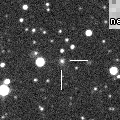
|
Now it is 16.0 mag (Mar. 30, Taras Prystavski). It keeps 16 mag for a long time until 2015 summer. It keeps observable in good condition in the Northern Hemisphere. It becomes observable only after 2015 in the Southern Hemisphere.
Date(TT) R.A. (2000) Decl. Delta r Elong. m1 Best Time(A, h)
Apr. 19 5 38.53 52 3.9 4.237 3.867 61 16.5 18:55 (153, -6)
Apr. 26 5 50.08 51 59.0 4.280 3.841 57 16.5 18:48 (152, -7)
|
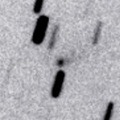
|
Now it is 16.8 mag (Apr. 5, J. F. Hernandez). It keeps 16.5 mag until June.
Date(TT) R.A. (2000) Decl. Delta r Elong. m1 Best Time(A, h)
Apr. 19 14 20.86 -10 30.4 1.158 2.156 171 16.7 0:35 (180, 66)
Apr. 26 14 14.26 -11 19.8 1.145 2.150 177 16.6 0:01 (180, 66)
|
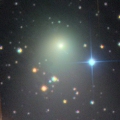
|
It became much brighter than expected, and reached up to 8.5 mag (Aug. 15, Alexandre Amorim). Now it is fading rapidly. It has already faded down to 16.3 mag (Mar. 30, Taras Prystavski). In the Southern Hemisphere, it will keep observable in good condition for a long time until 2014 summer when the comet fades out. It will never be observable again in the Northern Hemisphere.
Date(TT) R.A. (2000) Decl. Delta r Elong. m1 Best Time(A, h)
Apr. 19 16 23.43 -71 43.3 2.895 3.440 114 16.6 2:38 ( 0, 53)
Apr. 26 16 4.97 -71 17.9 2.901 3.509 119 16.8 1:52 ( 0, 54)
|
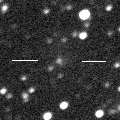
|
Now it is 17.9 mag (Mar. 9, W. Hasubick). Distant object, but it keeps observable at 14 mag for a long time from 2015 to 2016.
Date(TT) R.A. (2000) Decl. Delta r Elong. m1 Best Time(A, h)
Apr. 19 19 19.49 -3 29.4 7.036 7.232 97 16.8 5:02 (194, 58)
Apr. 26 19 20.42 -3 12.3 6.898 7.199 103 16.8 5:06 (180, 58)
|

|
Now it is 17.5 mag (Apr. 5, J. F. Hernandez). It keeps 17 mag for a long time from 2014 to 2015. It is observable in excellent condition in the Northern Hemisphere. It is observable only until 2014 summer in the Southern Hemisphere.
Date(TT) R.A. (2000) Decl. Delta r Elong. m1 Best Time(A, h)
Apr. 19 16 15.40 24 10.7 3.554 4.263 129 17.1 2:29 (180, 31)
Apr. 26 16 12.97 26 0.4 3.510 4.238 130 17.0 1:59 (180, 29)
|
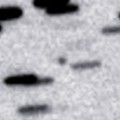
|
Now it is 17.0 mag (Apr. 5, J. F. Hernandez). It keeps 17-18 mag for a long time from 2014 to 2016.
Date(TT) R.A. (2000) Decl. Delta r Elong. m1 Best Time(A, h)
Apr. 19 14 40.13 -12 31.6 4.719 5.702 166 17.1 0:54 (180, 68)
Apr. 26 14 31.23 -12 17.8 4.680 5.684 175 17.1 0:18 (180, 67)
|
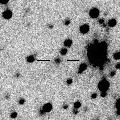
|
Now it is 17.5 mag (Apr. 5, N. James). It keeps observable at 18 mag for a long time from 2013 to 2016. It keeps locating high in the Northern Hemisphere. It keeps locating very low in the Southern Hemipshere.
Date(TT) R.A. (2000) Decl. Delta r Elong. m1 Best Time(A, h)
Apr. 19 19 11.64 40 28.5 6.449 6.516 89 17.2 5:02 (184, 14)
Apr. 26 19 8.47 41 52.9 6.385 6.510 92 17.2 4:54 (180, 13)
|

|
Now it is 18.2 mag (Apr. 22, D. Herald). It keeps 17-18 mag for a long time from 2013 to 2014. It is observable in excellent condition in the Southern Hemisphere. It is not observable in the Northern Hemisphere.
Date(TT) R.A. (2000) Decl. Delta r Elong. m1 Best Time(A, h)
Apr. 19 12 23.10 -59 14.7 3.983 4.684 129 17.2 22:32 ( 0, 66)
Apr. 26 12 4.82 -58 49.6 3.992 4.687 128 17.2 21:46 ( 0, 66)
|
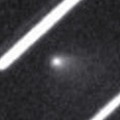
|
It brightened up to 15.1 mag at opposition in March (Mar. 11, Catalina Sky Survey). Now it is fading rapidly. It has already faded down to 17.4 mag (Apr. 18, K. Hills). It will be fainter than 18 mag in May.
Date(TT) R.A. (2000) Decl. Delta r Elong. m1 Best Time(A, h)
Apr. 19 10 56.33 29 47.2 1.474 2.181 122 17.2 21:05 (180, 25)
Apr. 26 10 34.74 31 21.2 1.655 2.226 111 17.6 20:16 (180, 24)
|

|
It was observed at 17.5 mag in early 2013. It will be observable at 17.5 mag again from spring to summer in 2014.
Date(TT) R.A. (2000) Decl. Delta r Elong. m1 Best Time(A, h)
Apr. 19 19 29.77 -13 3.6 2.478 2.777 96 17.4 5:02 (205, 66)
Apr. 26 19 34.87 -12 51.4 2.404 2.792 101 17.4 5:06 (189, 68)
|

|
Now it is 17.9 mag (Apr. 6, Ken-ichi Kadota). It keeps 17 mag for a long time until 2015.
Date(TT) R.A. (2000) Decl. Delta r Elong. m1 Best Time(A, h)
Apr. 19 10 47.32 -6 57.2 2.710 3.498 135 17.6 20:57 (180, 62)
Apr. 26 10 46.30 -6 30.5 2.764 3.484 128 17.6 20:29 (180, 62)
|

|
Now it is 18.1 mag (Mar. 29, M. Jaeger, W. Vollmann, E. Prosperi, S. Prosperi). It keeps 18 mag for a very long time from 2013 to 2018. It locates high in the Southern Hemisphere. But it locates somewhat low in the Northern Hemisphere.
Date(TT) R.A. (2000) Decl. Delta r Elong. m1 Best Time(A, h)
Apr. 19 10 56.98 -17 26.3 8.541 9.316 138 17.8 21:07 (180, 72)
Apr. 26 10 56.14 -17 6.7 8.602 9.311 132 17.9 20:39 (180, 72)
|
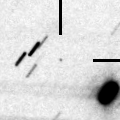
|
Now it is 17.6 mag (Mar. 28, A. Maury, J.-F. Soulier, T. Noel, J.-G. Bosch). It keeps 18 mag from spring to summer. It is observable in good condition in the Southern Hemisphere. It is not observable in the Northern Hemisphere.
Date(TT) R.A. (2000) Decl. Delta r Elong. m1 Best Time(A, h)
Apr. 19 17 10.01 -66 0.9 0.646 1.407 115 17.9 3:23 ( 0, 59)
Apr. 26 17 16.54 -66 25.6 0.652 1.438 118 17.9 3:03 ( 0, 59)
|
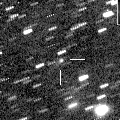
|
Now it is 18.1 mag (Apr. 20, Catalina Sky Survey). It keeps 18 mag for a long time from 2013 to 2014.
Date(TT) R.A. (2000) Decl. Delta r Elong. m1 Best Time(A, h)
Apr. 19 16 14.22 14 53.7 6.773 7.518 135 17.9 2:28 (180, 40)
Apr. 26 16 9.62 15 48.0 6.734 7.522 138 17.9 1:55 (180, 39)
|
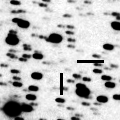
|
Now it is 18.5 mag (Mar. 31, Hidetaka Sato). It is observable at 18 mag in good condition from spring to summer.
Date(TT) R.A. (2000) Decl. Delta r Elong. m1 Best Time(A, h)
Apr. 19 20 34.00 -12 34.6 1.752 1.880 81 18.0 5:02 (233, 57)
Apr. 26 20 44.31 -10 8.0 1.699 1.894 84 17.9 5:06 (222, 59)
|
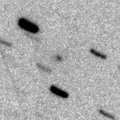
|
It approached to the earth down to 0.7 a.u., and brightened up to 17.2 mag in February and March (Feb. 24, A. Klotz, F. Kugel). Now it is 17.8 mag (Mar. 16, N. James). It is observable in excellent condition in the Northern Hemisphere. It locates very low in the Southern Hemisphere.
Date(TT) R.A. (2000) Decl. Delta r Elong. m1 Best Time(A, h)
Apr. 19 8 32.99 21 59.1 0.821 1.366 96 17.9 18:55 (177, 33)
Apr. 26 9 0.01 18 48.7 0.891 1.418 96 18.3 18:48 (179, 36)
|

|
Now it is 19.4 mag (Apr. 4, A. Waszczak). First return of a new periodic comet which brightened up to 13 mag in outburst in 2008. It will be observable in good condition from spring to summer. However, it will be only 19-20 mag at best in this apparition.
Date(TT) R.A. (2000) Decl. Delta r Elong. m1 Best Time(A, h)
Apr. 19 12 17.01 15 51.5 1.597 2.489 145 19.5 22:27 (180, 39)
Apr. 26 12 13.65 15 44.3 1.629 2.475 138 19.5 21:56 (180, 39)
|
|
![]()
 P/2012 B1 ( PanSTARRS )
P/2012 B1 ( PanSTARRS ) C/2012 K6 ( McNaught )
C/2012 K6 ( McNaught ) 124P/Mrkos
124P/Mrkos 52P/Harrington-Abell
52P/Harrington-Abell C/2013 V2 ( Borisov )
C/2013 V2 ( Borisov ) P/2014 E1 ( Larson )
P/2014 E1 ( Larson ) C/2012 V2 ( LINEAR )
C/2012 V2 ( LINEAR ) C/2011 KP36 ( Spacewatch )
C/2011 KP36 ( Spacewatch ) C/2013 G3 ( PanSTARRS )
C/2013 G3 ( PanSTARRS ) C/2013 G9 ( Tenagra )
C/2013 G9 ( Tenagra ) C/2012 K8 ( Lemmon )
C/2012 K8 ( Lemmon ) C/2013 G7 ( McNaught )
C/2013 G7 ( McNaught ) C/2014 C3 ( NEOWISE )
C/2014 C3 ( NEOWISE ) 280P/2013 C1 ( Larsen )
280P/2013 C1 ( Larsen ) 299P/2014 D2 ( Catalina-PanSTARRS )
299P/2014 D2 ( Catalina-PanSTARRS ) C/2013 C2 ( Tenagra )
C/2013 C2 ( Tenagra ) 294P/2013 X2 ( LINEAR )
294P/2013 X2 ( LINEAR ) C/2013 H2 ( Boattini )
C/2013 H2 ( Boattini ) 296P/2014 A1 ( Garradd )
296P/2014 A1 ( Garradd ) P/2013 TL117 ( Lemmon )
P/2013 TL117 ( Lemmon ) 297P/2014 D1 ( Beshore )
297P/2014 D1 ( Beshore )![]()








































